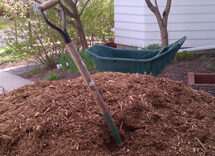Here are some ideas for how to mulch more effectively while spending less!

In the vegetable garden:
For most vegetables, use this tip from an Iowa gardener who grows tomatoes and peppers professionally. Once the soil warms up adequately in early June, lay down several layers of newspaper and top it with 1 to 3 inches of grass clippings. (If you use chemicals on your lawn, wait until after a good rain to collect and use any clippings. Of course, the ideal is not to use lawn chemicals at all.)
In the fall, just leave this mulch in place, even after you rip out your frost-felled veggies. The grass and newspaper will break down, feeding the soil. Work the remnants into the soil in spring, pulling out any big chunks that haven’t broken down.
In beds and borders:
Around my trees, shrubs, and flowers I like to use wood or bark chips, purchased in bulk from a landscape company ’cause it’s cheaper that way. (I go in with my neighbors and we split the delivery fee of about $15.)
I avoid colored mulches because personally I think they look kinda artificial. Also, the colorant tends to bleed onto sidewalks and drives.
Also, in Iowa, avoid rock and gravel. They’re a mess to remove down the road and most Iowa plants don’t appreciate them (unlike plants in the Southwest). Gravel and rock just makes the plants hot and don’t feed the soil the way biodegradable mulch does.
One other mulch to avoid: Freshly shredded wood. As it breaks down, it robs soils of nutrients and can actually stunt smaller plants. This is less important around trees and large, established shrubs, but it’s best to let it set in a pile for a year or so before using it as a mulch.
Spread mulch in beds and borders 1 to 3 inches thick. Keep it at 1 inch for short plants like annuals and up to 3 inches for larger plants. If you have permanent plantings, such as trees and shrubs, you can first lay down black porous landscape fabric (not plain black plastic—it doesn’t allow water through) for even better weed control.
Note: If you’ve mulched before around your beds and borders, each spring, just top it off here and there, where needed.
You might also be interested in:
Please do not use content from this site without express permission from The Iowa Gardener. Click here to request permission.